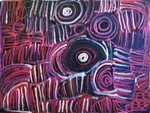Minnie Pwerle
Awelye Atnwengerrp
16
votes


Minnie Pwerle
Awelye Atnwengerrp
Medium: Acrylic on canvas
Size: 120 x 90 cm
Year: 2001
Price: $ POA
POA
Minnie Pwerle was born circa 1910 and died 18th March 2006, her country is Atnwengerrp and her language is Anmatyerre and Alyawarr.
Minnie Pwerle’s emergence and dominance in the world of mainstream art has been compared to the legendary Emily Kame Kngwarreye, who like Minnie, began her painting career in her mid seventies and continued to paint with an energy that belied her age. Minnie Pwerle also possessed incredible energy, and this was often reflected in her depiction of "Awelye Atnwengerrp" dreamings. These works were created in a linear style sometimes loose and free flowing or tight and clustered or a combination of both. Either way, Minnie Pwerle’s ability to capture her long love of the land was always true.
Minnie Pwerle exhibited her works extensively throughout Australia and the world with great success. She is regarded as one of Utopia’s foremost artists, with her paintings in continual and constant demand from galleries and private collectors.
Women’s Ceremony – “Awelye”
In Aboriginal culture, ceremonies are focal points in the life of the community. They are held for different purposes, but are integral to the happiness and well being of the people. The people dance and celebrate to acknowledge the fertility of the land, the health of the people, the initiation of young men or to mourn the passing of a loved one.They would smear their bodies with animal fat and would then trace certain ceremonial designs on the top half of their body using a variety of powders, ground from charcoal and yellow and red ochre. They would gather together and sing and dance led by the most senior women of the clan group.
The women’s ceremony is kept separate to the man’s ceremony, though each one is equally as important. The main point is that the people are demonstrating their respect and love for the land. The body paint designs would vary from ceremony to ceremony and would depend on the subject and the time of year the ceremony is held. Different symbols are painted on the body and may vary from person to person depending on the seniority of each member.
DACOU
The Art Lover's Vote
Vote for this artwork and share it with other Aboriginal art devotees!
16
votes
Further Research
Tags: living the land
Similar artworks: Ngintaka tjukurpa | APY Country | APY Country | Kapitjukula (Waterholes) | Ngayuku ngura (My Country) | Untitled | Ngayuku ngura (My Country) | Kapi tjukula - Rock hole | Tjala Honey Ant Tjukurrpa | Wilkinkarra |
Selected News Archive hosted by News Aboriginal Art Directory
- 20.05.14 | Man on Fire: the Art of Tim Storrier and Other Desert Masters
- 24.04.14 | Desert Song and the Pike Family
- 31.03.14 | Painting is the Skin of the World



